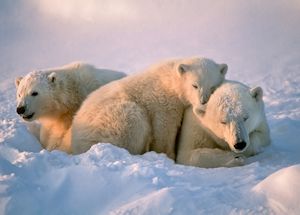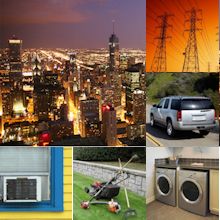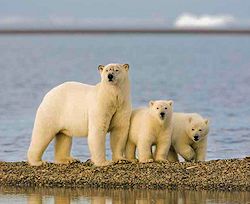Polar Bears and Climate Change
Simply Amazing

Polar Bears are amazing. They're perfectly designed for the Arctic, one of the coldest places on earth. They have two layers of fur that keep them warm at -50°F, have furred feet that keep them from slipping on ice, have an incredible sense of smell to direct them to food in a large landscape, and are strong enough to pull a large seal from the sea for food.
The mother bear is masterful at taking care of her cubs. She dens in the fall after building fat reserves and nurses her newborns to strength in the dead of winter. The cubs comes out of the den in the early spring and head out on the ice for food. They rumble and play, explore new smells, learn to forage, and play with a growing understanding of the world around them. In the first couple of years they are completely dependent on the protection and skills of their mother. She, in turn, depends on the predictable rhythms of nature and the food it provides.
Her world is unique.
The Arctic Is Changing

She doesn't know what life is like in mega cities like Chicago or Shanghai where the lights are on 24 hours a day and traffic jams are a daily occurrence. She doesn't know what an SUV is, or how much coal it takes to do your laundry, or to heat and cool your home. She doesn't know about exhaust from gas powered lawnmowers and leaf blowers, or how much carbon it takes to heat the water in your backyard pool. She doesn't know about vampire power, escalators, neon signs, or power plants; all of which rely on coal, gas and oil, and that send greenhouse warming gases into the atmosphere.
What she does know is that it's getting harder to find food. During the summer months, when she's hunting for her cubs, the ice she relies on to hunt for seals is further and further from land, retreating more each year as the arctic warms, requiring her to swim longer and longer distances to find the seals on which she relies. She knows the harshness of her hunger, and that of her cubs, when her fat reserves have dwindled following summers where she has not found enough to eat.
She knows an environment that is changing ....making it more difficult to survive.
The Arctic is a Special Place

At the ClimateStore, we understand the between fossil fuel use, climate change, and the very survival of polar bears. We trust the scientific community which has painstakingly shown that climate change is real and that the most dramatic changes are taking place in the arctic. We also believe there is
We're committed to providing products and ideas so you can reduce your energy use, live sustainably, and ultimately, help the polar bears. Maybe not these polar bears, but others like them, by protecting the ecosystem on which they depend.
Reducing Our Carbon Footprint will Help Save the Polar Bears
Scientists say the single most important thing we can do to save the polar bears is to reduce our carbon emissions...
References
E. Stokstad (2010). "How To Save Polar Bears" Science Now
Amstrup, S. C., E. T. DeWeaver, D. C. Douglas, B. G. Marcot, G. M. Durner, C. M. Bitz and D. A. Bailey (2010). "Greenhouse gas mitigation can reduce sea-ice loss and increase polar bear persistence." Nature 468 (7326): 955-958.




